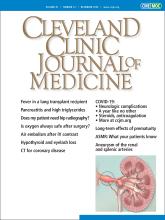A 41-year-old woman with chronic L3 radiculopathy and intermittent asthma controlled with as-needed short-acting beta-agonists presents after falling from standing. She reports no new pain or changes in her low-back pain. She has no history of systemic or inhaled steroid therapy, malignancy, osteoporosis, menopause, high-force trauma, smoking, substance abuse, or debilitating disease.
She has tenderness on her lower back, but not in the hip, and is able to bear weight. Her legs are symmetric and without deformities. Her left hip demonstrates full range of motion. A straight-leg test sharply increases her radiculopathic pain. Muscle strength is preserved, except for her left hip flexors and adductors, which have 4+ strength on a scale of 5.
HIP RADIOGRAPHY GUIDELINES LACKING FOR YOUNGER ADULTS
Between 21% and 35% of adults fall from standing every year, and internists will inevitably encounter such patients.1 There are clinical guidelines on when a patient needs knee or ankle radiography after sustaining an injury,2,3 but there are no similar high-value care guidelines for hip films. Consequently, clinicians routinely obtain hip radiographs regardless of the patient’s age, the nature of the injury, the presence of risk factors, or the physical examination findings.4
RISK FACTORS FOR HIP FRACTURES
Age and sex, as markers for osteoporosis, are the strongest risk factors for hip fracture.4,5 Hip fractures increase exponentially after age 60, with a 20% to 30% lifetime risk by age 90.5,6 From age 60 to age 80, the hip fracture rate in women increases from 78 to 1,084 per 100,000, and in men from 56 to 658 per 100,000.5
On the other hand, hip fractures are uncommon in adults under age 50, even though this group has a high frequency of injuries. A study looking at 28 million emergency room visits found only 20,000 hip fractures in patients under age 50.5
High-energy trauma, eg, from a motor vehicle accident, a fall from a height, or a sports injury such as in bicycling or ice-skating, is another risk factor for hip fracture4,7,8; 56% of hip fractures in patients under age 50 are from high-energy trauma.4,5,7,8
On the other hand, 90% of hip fractures in those age 60 and older occur after a fall from standing, ie, a low-energy trauma.5,6 In contrast to fractures in patients age 60 and older, most hip fractures in people under 50 are in men (70%), reflecting the historical association between male sex and activities involving high-energy trauma.6–8
Debilitating diseases such as cancer, chronic systemic steroid therapy, heavy alcohol intake (> 10 drinks per week), smoking (> 1 pack per day), or substance use disorder are other important risk factors for hip fracture.2–4 White people have a higher incidence of hip fracture than other racial groups, a factor that correlates with the higher incidence of osteoporosis in this group.7,8
SYMPTOMS, FINDINGS, AND INITIAL EVALUATION
Patients with hip fracture report pain in the groin that may radiate to the knee, a phenomenon more commonly encountered in younger patients.4 Pain in the low back, pelvis, or thigh or with a different radiation pattern indicates another process.4 All patients report exquisite tenderness when pressure is applied to the affected hip.4 Two-thirds of patients under age 50 present with a displaced fracture resulting in a shortened and externally rotated limb, inability to bear weight, and inability to move the joint in any direction actively or passively.2
Patients age 65 and older have a higher incidence of impacted hip fractures that permit joint range of motion, albeit with pain, and have no shortened, externally rotated limb, allowing for weight-bearing.4 Between 40% and 75% of patients under 50 present with hypotension or have other injuries from high-energy trauma.4
DOES OUR 41-YEAR-OLD PATIENT NEED A HIP RADIOGRAPH?
Our patient has no factors that would place her at high risk for hip fracture. She is 41 and premenopausal, has no debilitating disease, is not on chronic systemic or inhaled corticosteroids, and does not smoke or drink alcohol heavily. Her trauma was low-energy. She reports no groin pain. On physical examination, the hip has normal range of motion, and the limb is not shortened, rotated, or deformed. She is able to bear weight. The subtle physical examination findings are consistent with the patient’s chronic L3 radiculopathy.
For a patient such as this, a physician would have to order at least 200,000 hip films (costing about $58 million) in order not to miss a hip fracture.5–8 The number could be as high as 1 million hip films ($290 million) if the patient’s lack of risk factors is fully accounted for.5–8
In summary, hip radiographs should not be routinely obtained for adults under age 50 who have low-energy trauma, have no risk factors for hip fracture, have a benign physical examination, and are able to bear weight. On the other hand, plain radiography should be strongly considered for patients age 60 and older, as 90% of hip fractures in this population occur after low-energy trauma, and they can present with impacted fractures with no evidence of limb-shortening or external rotation allowing joint movement and weight-bearing.4
Acknowledgment
Dr. Moreno would like to thank Timothy Weitz, JD, John Bedolla, MD, FACEP, and Patrick J. Crocker, DO, MS, FACEP, for their insights.
Footnotes
The authors report no relevant financial relationships which, in the context of their contributions, could be perceived as a potential conflict of interest.
- Copyright © 2020 The Cleveland Clinic Foundation. All Rights Reserved.






